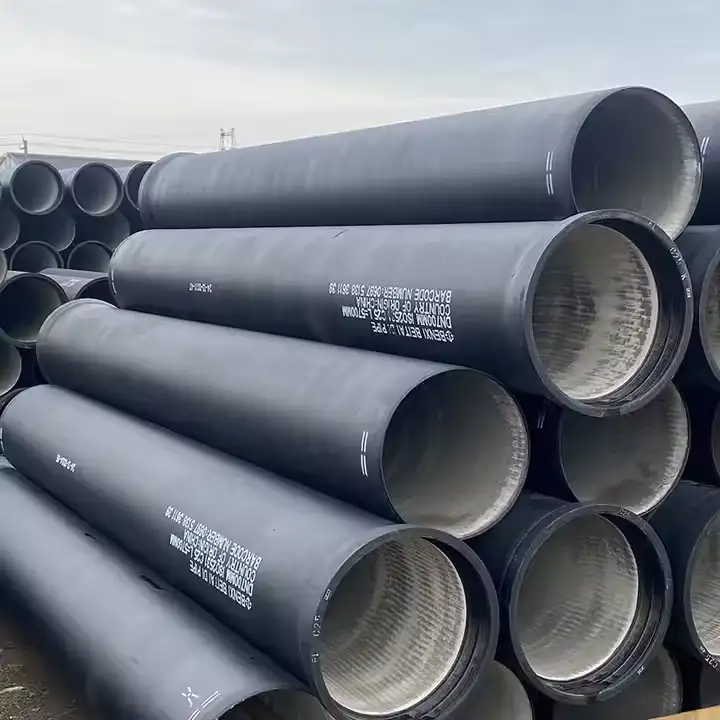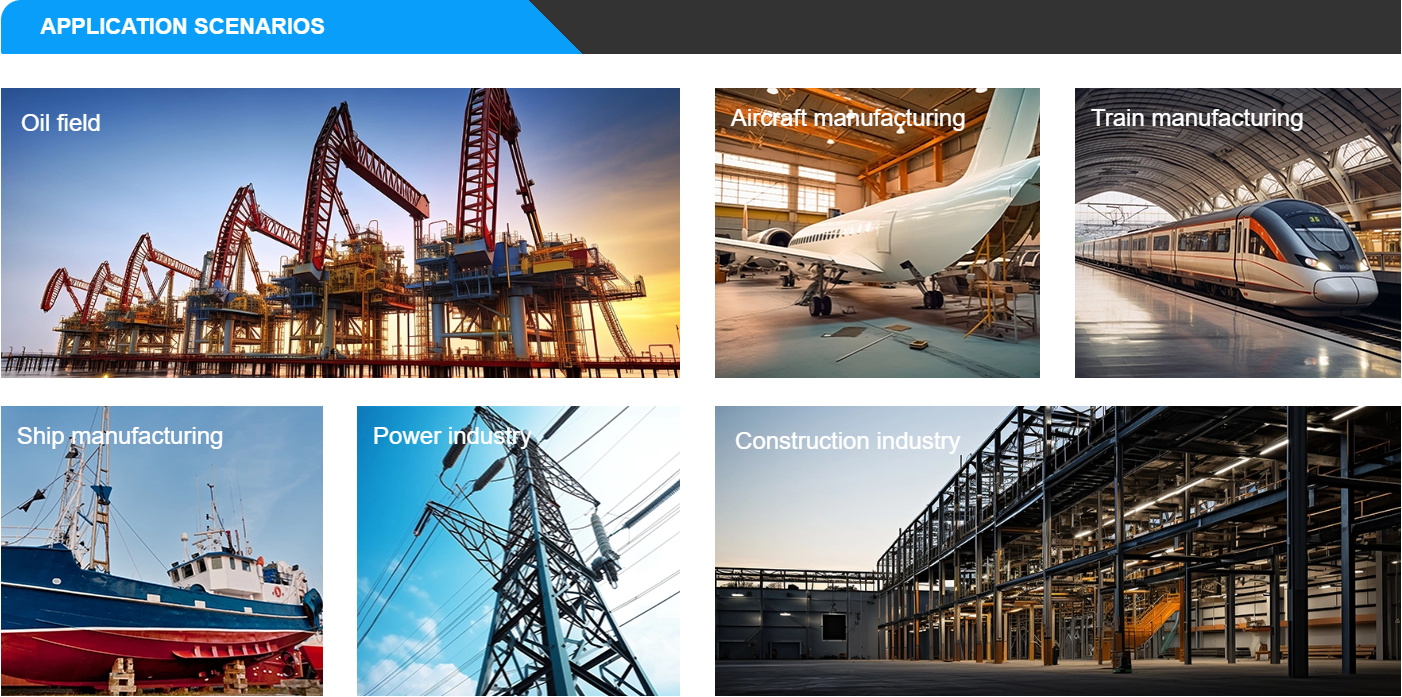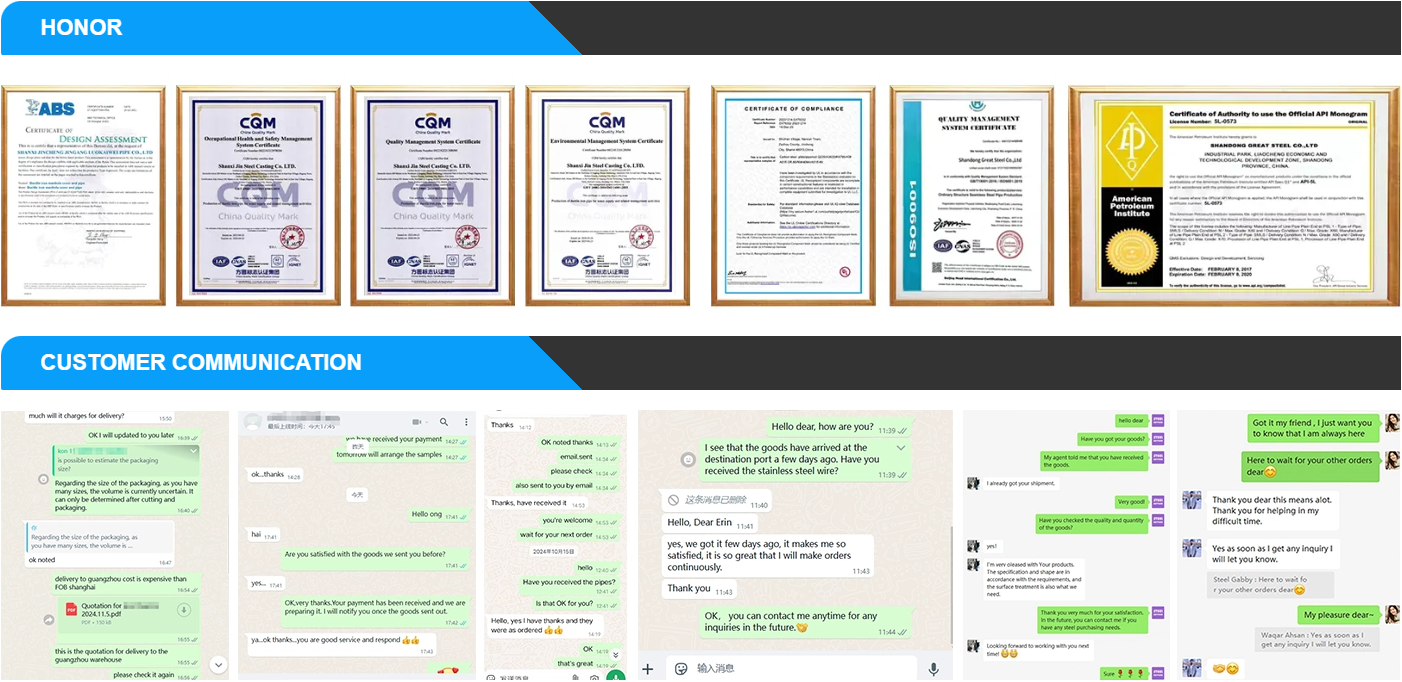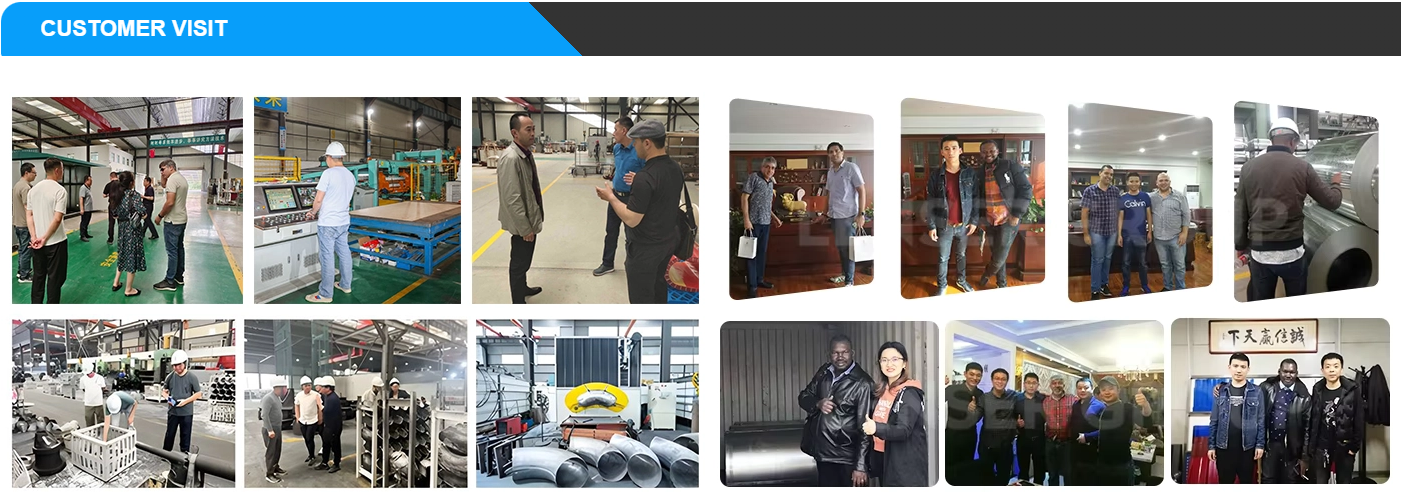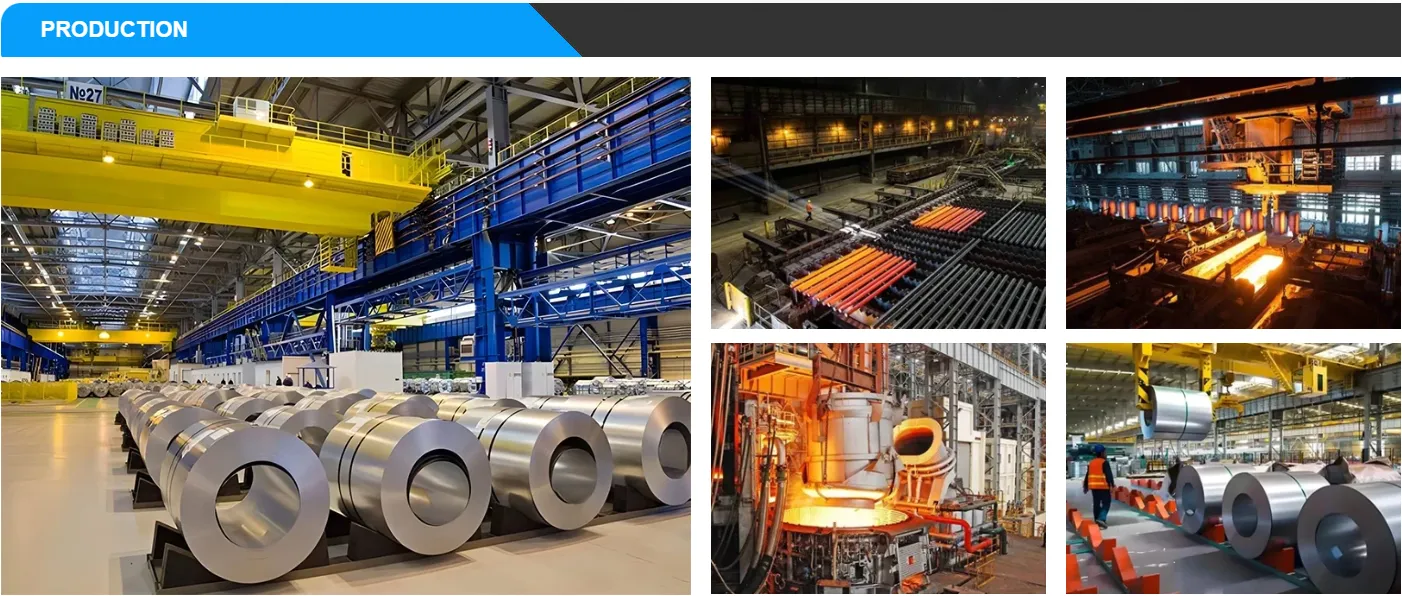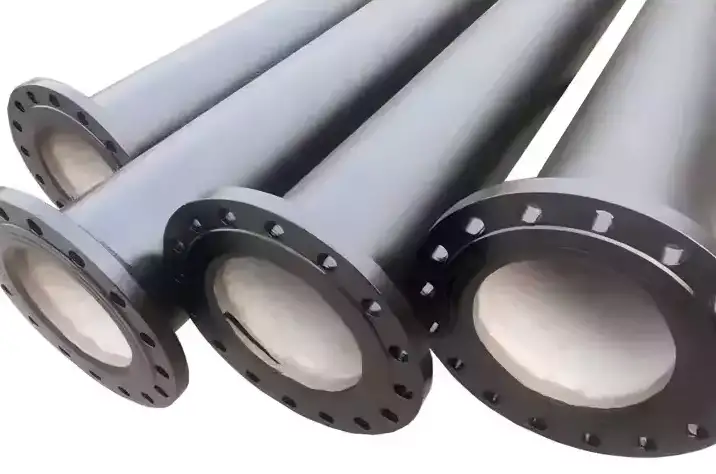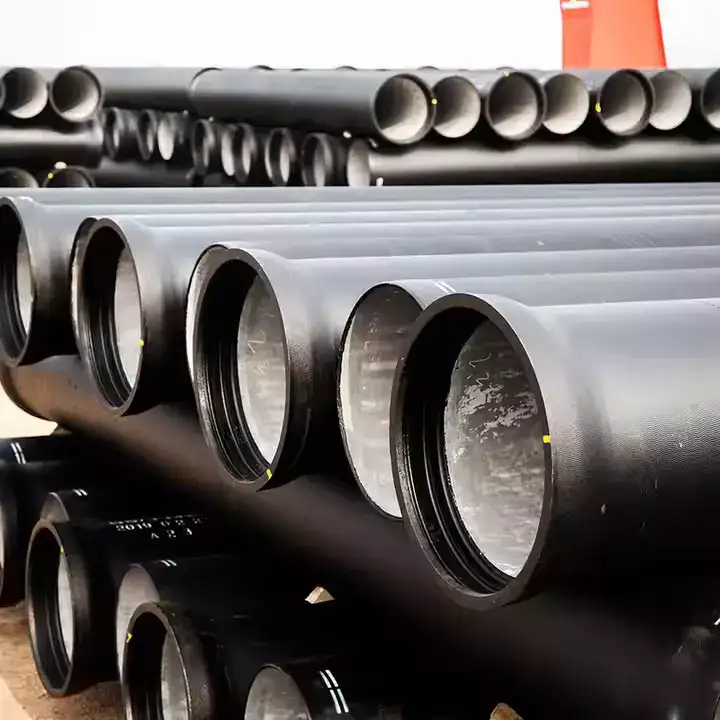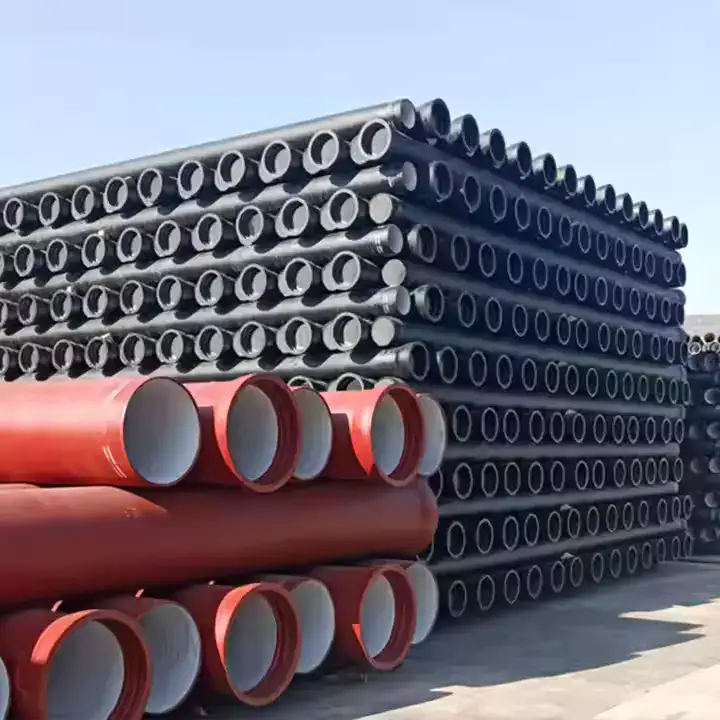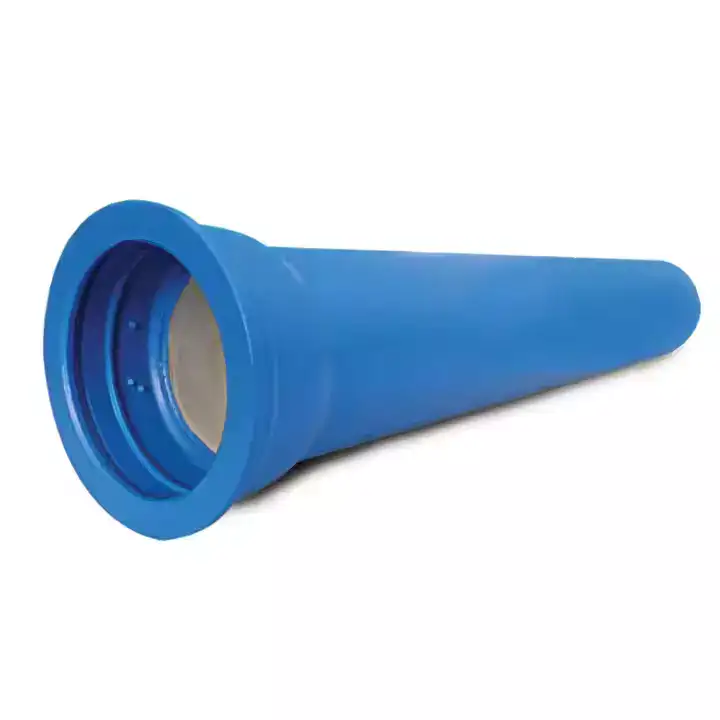Class 50–56 represent special “thickness classes” of ductile iron pipe (DIP), while Classes 150, 250 and 350 are standard pressure classes rated for 150 psi, 250 psi and 350 psi working pressure respectively. DIP enjoys a service life of 100 + years in most environments due to its high strength, cement‑mortar lining and optional external corrosion protection. It is widely used for potable water, sewage, irrigation, fire protection and industrial liquids, installed via push‑on (“Tyton”), mechanical or flanged joints per AWWA, ISO and EN standards. Life‑cycle cost analyses show DIP to be among the most cost‑effective materials over its lifespan, often saving millions in energy and replacement costs.
Applications
Ductile iron pipe is the material of choice for potable water transmission and distribution networks worldwide due to its strength and joint flexibility. It is also extensively used in sewage collection, irrigation systems, fire‑protection mains and industrial process lines thanks to its abrasion resistance and pressure capacity.
Service Life
Modern ductile iron pipe is engineered to last over 100 years under normal operating conditions, outperforming materials like PVC or HDPE. Cement‑mortar linings and advanced external coatings (zinc, asphaltic, polyethylene sleeving) effectively eliminate internal corrosion and greatly extend service life.
Technical Specifications
Parameter Table
Below is a summary of the key series, ratings and typical nominal wall‑thickness ranges per AWWA C150/A21.50 and ANSI/AWWA C151/A21.51:
| Series | Type | Rating | Wall Thickness (range) |
|---|---|---|---|
| Class 50–56 | Special Thickness | n/a | 6.35 – 9.78 mm (depending on size & class) |
| Class 150 (C150) | Pressure Class | 150 psi / 1.03 MPa | 6.35 – 22.2 mm |
| Class 250 (C250) | Pressure Class | 250 psi / 1.72 MPa | 7.1 – 24.3 mm |
| Class 350 (C350) | Pressure Class | 350 psi / 2.41 MPa | 8.0 – 27.6 mm |
Installation & Connection
The most common DIP joint is the push‑on “Tyton” joint, which uses a resilient gasket to form a watertight seal with simple assembly in the field. Mechanical joints employ a gland and bolts compressing a rubber gasket; they are ideal for connecting valves, fittings and creating restrained connections. Flanged joints, conforming to ANSI B16.1 or EN 1092, allow disassembly and are used where axial loads or maintenance access are required.
Series Differentiation
“Thickness classes” (50–56) specify nominal metal wall thickness for special design or deep cover applications, independent of pressure rating. “Pressure classes” (150, 250, 350) directly denote the pipe’s allowable working pressure (psi), with wall thickness calculated to include surge allowance.
International Standards
DIP and its joints/fittings comply with:
-
ANSI/AWWA C150/A21.50 (Thickness design)
-
ANSI/AWWA C151/A21.51 (Centrifugally cast pipe)
-
ANSI/AWWA C104/A21.4 (Cement‑mortar linings)
-
ANSI/AWWA C105/A21.5 (Polyethylene encasement)
-
BS EN 545 / ISO 2531 (European/ISO pipe dimensions and wall classes)
Price Comparison with Other Series
A recent Louisville Water Company bid (July 2024) illustrates unit prices per foot for 4″ and 6″ cement‑lined DIP (CI Pipe Co. vs. Core & Main vs. Ferguson):
| Size | CI Pipe Co. ($/ft) | Core & Main ($/ft) | Ferguson ($/ft) |
|---|---|---|---|
| 4″ | 41.82 | 37.11 | 43.69 |
| 6″ | 27.50 | 26.08 | 29.86 |
As a point of comparison, a standalone retailer lists 6″ CL 350 DIP at $30.75/ft.
Advantages
-
Longevity: > 100 years life expectancy, reducing replacement frequency.
-
Strength & Toughness: High impact resistance and ability to withstand surge pressures.
-
Corrosion Control: Proven linings/coatings and optional cathodic protection mitigate soil corrosion.
-
Versatile Jointing: Multiple joint options (push‑on, mechanical, flanged, restrained) for site-specific needs.
-
Sustainability: Recyclable material and low life‑cycle energy consumption.
FAQ
Q1: How do I choose between a thickness class and a pressure class?
Thickness classes (50–56) are selected when specific wall thickness is needed (e.g., deep cover); pressure classes (150–350) match the internal pressure requirements.
Q2: What corrosion protections are available?
Standard protection includes cement‑mortar lining, asphaltic or zinc coatings, polyethylene sleeving and optional cathodic protection.
Q3: Can DIP be used in seismic zones?
Yes—special restrained joints (e.g., TR Flex®, ball‑and‑socket) accommodate ground movement for seismic resilience.
Q4: What are typical sizes and availability?
DIP is manufactured in diameters from 3″ to 64″ (and larger on request), in 20 ft nominal lengths or custom‐fabricated sections.
Q5: How does DIP compare cost‑wise to PVC?
Although unit cost may be higher, DIP’s longer service life and lower maintenance yield lower life‑cycle cost versus PVC’s ~50 year lifespan.
Case Studies
-
Huntsville, AL: A Black & Veatch study found that over a 50‑year ductile iron service life, utilities save a present value of $17 million in operating costs.
-
Florida Corrosion Test Site: DIP encased in loose polyethylene sleeving remained in “excellent condition” in aggressive soils, validating LPS effectiveness.
ductile iron pipe dimensions
| Pipe body weight (kg/m) | |||||||||||||||
| (Inside Diameter) | (Outside Diameter) | Socket Weight | K8 | K9 | K10 | C class | Total weight of Active Length=6M (kg) | Total weight of Active Length=5.7M (kg) | |||||||
| DN(mm) | OD(mm) | ≈ kg | Class | kg/m | K8 | K9 | K10 | C class | K8 | K9 | K10 | C class | |||
| 80 | 98 | 3.40 | 12.20 | 12.20 | 12.20 | C40 | 9.10 | 77.00 | 77.00 | 77.00 | 58.00 | 73.00 | 73.00 | 73.00 | 55.00 |
| 100 | 118 | 4.30 | 14.90 | 15.10 | 15.10 | C40 | 11.12 | 93.70 | 95.00 | 95.00 | 71.00 | 90.00 | 91.00 | 90.00 | 68.00 |
| 125 | 144 | 5.70 | 18.90 | C40 | 119.00 | ||||||||||
| 150 | 170 | 7.10 | 21.80 | 22.80 | 22.80 | C40 | 16.48 | 138.00 | 144.00 | 144.00 | 106.00 | 132.00 | 138.00 | 137.00 | 101.00 |
| 200 | 222 | 10.30 | 28.70 | 30.60 | 30.60 | C40 | 22.62 | 183.00 | 194.00 | 194.00 | 146.00 | 174.00 | 185.00 | 185.00 | 139.00 |
| 250 | 274 | 14.20 | 35.60 | 40.20 | 44.30 | C40 | 32.63 | 228.00 | 255.00 | 280.00 | 210.00 | 218.00 | 244.00 | 267.00 | 200.00 |
| 300 | 326 | 18.90 | 45.30 | 50.80 | 56.30 | C30 | 43.90 | 290.00 | 323.00 | 357.00 | 282.00 | 278.00 | 309.00 | 340.00 | 269.00 |
| 350 | 378 | 23.70 | 55.90 | 63.20 | 69.60 | C30 | 51.88 | 359.00 | 403.00 | 441.00 | 335.00 | 343.00 | 384.00 | 420.00 | 319.00 |
| 400 | 429 | 29.50 | 67.30 | 75.50 | 83.70 | C30 | 60.78 | 433.00 | 482.00 | 532.00 | 394.00 | 414.00 | 460.00 | 506.00 | 376.00 |
| 450 | 480 | 38.30 | 80.00 | 89.30 | 99.00 | C30 | 73.30 | 515.00 | 575.00 | 632.00 | 472.00 | 492.00 | 550.00 | 597.00 | 450.00 |
| 500 | 532 | 42.80 | 92.80 | 104.30 | 115.60 | C30 | 87.20 | 600.00 | 669.00 | 736.00 | 566.00 | 572.00 | 638.00 | 702.00 | 540.00 |
| 600 | 635 | 59.30 | 122.00 | 137.30 | 152.00 | C30 | 120.62 | 791.00 | 882.00 | 971.00 | 783.00 | 755.00 | 842.00 | 926.00 | 747.00 |
| 700 | 738 | 79.10 | 155.00 | 173.90 | 193.00 | C25 | 142.15 | 1009.00 | 1123.00 | 1237.00 | 932.00 | 963.00 | 1071.00 | 1179.00 | 889.00 |
| 800 | 842 | 102.60 | 192.00 | 215.20 | 239.00 | C25 | 177.07 | 1255.00 | 1394.00 | 1537.00 | 1165.00 | 1197.00 | 1330.00 | 1465.00 | 1112.00 |
| 900 | 945 | 129.60 | 232.00 | 260.20 | 289.00 | C25 | 197.68 | 1521.00 | 1691.00 | 1863.00 | 1446.00 | 1452.00 | 1613.00 | 1777.00 | 1257.00 |
| 1000 | 1048 | 161.30 | 275.00 | 309.30 | 343.20 | C25 | 266.28 | 1811.00 | 2017.00 | 2221.00 | 1759.00 | 1729.00 | 1925.00 | 2118.00 | 1679.00 |
| 1100 | 1152 | 194.70 | 362.80 | 2372.00 | |||||||||||
| 1200 | 1255 | 237.70 | 374.00 | 420.10 | 466.10 | C25 | 373.88 | 2482.00 | 2758.00 | 3034.00 | 2481.00 | 2370.00 | 2632.00 | 2894.00 | 2369.00 |
| 1400 | 1462 | 279.30 | 547.20 | 3563.00 | |||||||||||
ductile iron pipe Mechanical property
| Mechanical Property | |||||||
| Nominal Diameter | Hydraulic test | Tensile strength | Elogation | Yield strength | Bending strength | Brinell hardness | Thickness of cement lining |
| DN(MM) | Mpa | Mpa | % | Mpa | Mpa | HB | mm |
| DN80-DN300 | 5 | ≥420 | ≥10 | ≥300 | ≥590 | ≤230 | 3 |
| DN350-DN600 | 4 | ≥420 | ≥10 | ≥300 | ≥590 | ≤230 | 5 |
| DN700-DN1000 | 3.2 | ≥420 | ≥10 | ≥300 | ≥590 | ≤230 | 6 |
| DN1100-DN1600 | 2.5 | ≥420 | ≥7 | ≥300 | ≥590 | ≤230 | ….. |

